What you’ll learn in this article:
1. How our eyes aren’t a camera, they’re a clock.
2. What are opsins?
3. Why carrots won’t help our eyes
4. How mitochondria regulate our metabolism
5. How our hormones are affected by light
6. Our evolutionary Big Picture
7. Health strategies we can apply today
The current paradigm in ophthalmology says that UV light is really bad for the eye and skin. Well, if that was true why would Mother Nature have put a UV-A detector in the cornea and in the skin?
- Jack Kruse, M.D.
Our eyes aren’t a camera, they’re a clock.
Our bodies function according to a circadian rhythm, which is governed by a master clock, known as the supraciasmatic nucleus (SCN), located in the hypothalamus of our brain.
The retina is the only part of our bodies that can bypass this master clock. It turns out that we have photoreceptors in our eyes that can set their own internal circadian rhythm by directly synchronizing to light without input from the brain.
What does this have to do with obesity?
When these photoreceptors are damaged by being exposed to harmful amounts of blue light, our metabolism is directly affected.
As I’ll explain in this article, these photoreceptors bind with retinol, a form of Vitamin A. When this bond is broken, Vitamin A becomes a wrecking ball in our metabolism, not allowing certain hormones such as leptin, which gives us the feeling of being satiated from a meal and full, to no longer work.
Let’s break down this process, which starts with light hitting our…
Opsins - the unsung heroes
Many of us have heard of rods and cones, which process visual images for our brains to “see”, however our eyes contain other photoreceptors that do not see anything at all - they keep time.
These photoreceptors are melanopsin and neuropsin.
Melanopsin processes the light around us as a non-visual signal, or timestamp, and sends this to our SCN. This in turn regulates our circadian rhythm – which dictates when we wake up, are fully alert, hungry, and tired.
“For many years people viewed the eye as if it were an old-style camera, without a light meter. The discovery of the first non-visual opsin, melanopsin (1998), identified the first light meter in the eye. “
Ethan Buhr, Research Professor, Johns Hopkins & Cincinatti Children’s Hospital
Neuropsin is another type of photoreceptor that was only discovered recently (2009) to operate independently of the SCN. A University of Washington study confirmed that when rod, cone, and melanopsin cells were removed from mice, their circadian rhythms continued, however researchers were surprised that their retinas were still responsive to light changes due to the presence of neuropsin.1
When neuropsin was removed, the mice lost all ability to adapt to changing patterns of light and dark.
Why is this important?
Our metabolism, along with the hormones and genes that our bodies ultimately express are all based on these cycles of light and dark - our circadian rhythm.
When we lose our ability to track time, no amount of vitamins or supplements will help us.
How can we ensure this doesn’t happen?
First, we must understand what drives the gears of our Divine Swiss timepiece.
Vitamin A - Don’t be a carrot. Be the light.
All opsins bind to a form of vitamin A called retinol. Get it…retina - ol?
Vitamin A in the form of retinol only comes from animal foods. We are often told that we can get a bioavailable form of Vitamin A from the beta carotene (a type of carotenoid) in vegetables like carrots. Many of us are poor converters of beta carotene.
We can however, convert the carotenoids, which come from eggs, shellfish, salmon and liver, very easily to this active form of Vitamin A - retinol.
Blue light toxicity on the eye or skin ruins the conversion of carotenoids to an active form of Vitamin A (retinol) our bodies can use, and this causes circadian rhythms to be disrupted.
When blue light from AM sunshine first enters our eyes, Vitamin A within the brain transforms the light signal to tell our bodies it’s daytime.
Ok ready for a bit more science? Good.
The opsins in our eyes have a very loose bond to retinol. Retinol controls the neural signaling along the central retinohypothalamic tract (below).
This tract connects the retina to the suprachiasmatic nucleus (SCN), and also connects to the leptin receptor in the hypothalamus. Leptin is a hormone our bodies produce which give us the feeling of being full, or satiated after a meal.
What happens when the bond between retinol and our opsins is broken?
Retinol is liberated in our system. While this may sound like a good thing, free retinol actually creates chaos in our bodies as it’s meant to be coupled with our photoreceptors during the waltz of our metabolism.
Have you ever heard the phrase free radicals?
Free radicals constantly seek to bind with another atom or molecule to become stable. Electrons need to be paired to be stable. What ensues is a chain reaction of electrons being paired to the wrong molecules.
Basically when we have too many electrons flowing too quickly in our bodies, our metabolism breaks down.
The mitochondria get a D
As retinol (Vitamin A) gets liberated, this lowers Vitamin D as a result.
UV light creates Vitamin D, which binds to our mitochondria, the engines of our cells, which regulate our metabolism by slowing electron chain flow. When electron flow in our bodies is slowed down, we tend to eat less food as our metabolism runs more efficiently.
Our entire metabolism runs on what is called the electron transport chain. When we’re exposed to harmful amounts of EMF or blue light, the last link in the chain is broken and digestion breaks down.
Light from the sun also stimulates melanin, which helps give our metabolism a boost. For example α-melanocyte-stimulating hormone (α-MSH) has been shown to induce weight loss in animals, but its absence can lead to less melanin, which ultimately leads to disease. How does this happen?
You down with POMC, ya you (don’t) know me.
Ok a bit more science, we’re almost done. Proopiomelanocortin (POMC) is a prohormone part of our melanocortin system of hormonal pathway,2 which makes other hormones and endorphins in our bodies. Hormones tell our bodies what to do.
The melanocortin system is a critical regulator of energy balance. Much of what is known about our brain’s control of overall energy balance and fat storage stem from what we know about the melanocortin system and leptin.
“This is why modern humans are getting fat = leptin-melanocortin pathways have lost their melanin due to a lack of sun.”
POMC needs sunlight and the right amount of thyroid stimulating hormone (TSH) to work efficiently. Ultimately POMC helps us maintain blood sugar levels, protects the body from stress, and suppresses inflammation.
POMC, like our photoreceptor melanopsin, is also located in our subcutaneous fat:
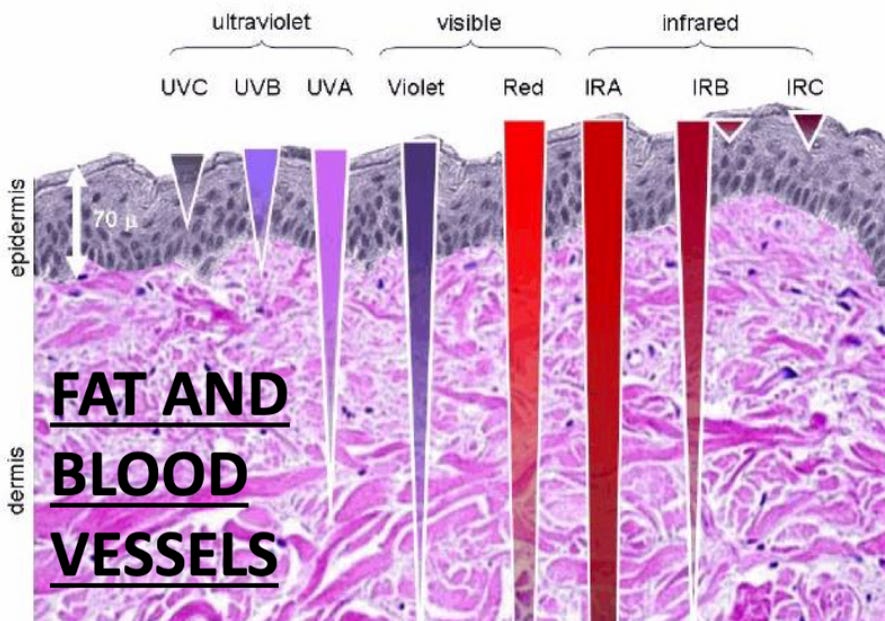
Why is this important?
If you live under toxic indoor fake light, and aren't covering your eyes with blue-blocking glasses as well as your skin, you won’t make POMC very well. This can cause a lack of mitosis, which means your cells can’t divide well, leading to obesity and cancer.3
POMC is ultimately regulated by leptin. However when our opsins are destroyed, and retinol becomes a liberated wrecking ball, our leptin levels also fall, along with dopamine, melanin, and melatonin.
Remember the Big picture
Remember those neuropsins that function independently of our brain’s SCN?
Ever wonder why we have them?
A prevalent theory, which I love, was put forth by neurosurgeon and mitochondriac Jack Kruse. After an asteroid wiped out the dinosaurs 65 million years ago, light from the Sun would be sparse. Certain parts of the solar spectrum, such as UV-B and UV-C would not be able to penetrate the dense particulate matter in the atmosphere, and only UV-A light would be able to get through.
The eutherian mammals (any mammal with a placenta) made it through this massive extinction event, as their eyes learned to adapt to those low-level environments. We come from those mammals.
What spectrum are our neuropsin receptors most sensitive to?
UV-A and violet light up to 400 nm.
When considering any health decision, it’s important to have the big picture in context. Basically- see that UV-A light to build your neuropsin and get down with your POMC!
What are some strategies we can take to boost our metabolism?
Again - remember that big picture…or should I say, Great Ball of Fire?
Getting out into the Sun and exposing our eyes and skin gradually have been shown to have many potent health benefits, which don’t only include improving our immune system with vitamin D.
I like to build melanin in my skin by exposing as much of my body as my neighbors will tolerate, especially between the hours of 9am-11am, as this is when our subcellular melatonin (a second type found in our skin) can be replenished the most effeciently.
I also love to watch the Sunrise, as the infrared light along with other frequencies are more abundant at this time. I’ll usually try to stay out until the Sun is at a 15 degree angle to the horizon, as this is when its benefits are felt most by our metabolism. This angle is when the red light our mitochondria love, is most abundant.4
See you out there!
You are more powerful than you know.
Roman S Shapoval
Additional resources
For a primer on circadian rhythms related to our individual metabolism:
How EMF impacts metabolism:
How Diabetes is an Electrical Illness
Help support our research on hidden health topics!
Let's swim upstream against the mainstream together:
Consider becoming a paid subscriber:
Listen to our podcast - The Power Couple
We discuss how we:
Power ON with light
Power OFF our devices
Power thru our days with relationships that all start with - YOU.
New episodes each Friday:
If you enjoyed this article and found it valuable, share the knowledge!
Buhr ED, Vemaraju S, Diaz N, Lang RA, Van Gelder RN. Neuropsin (OPN5) Mediates Local Light-Dependent Induction of Circadian Clock Genes and Circadian Photoentrainment in Exposed Murine Skin. Curr Biol. 2019 Oct 21;29(20):3478-3487.e4. doi: 10.1016/j.cub.2019.08.063. Epub 2019 Oct 10. PMID: 31607531; PMCID: PMC6814305.





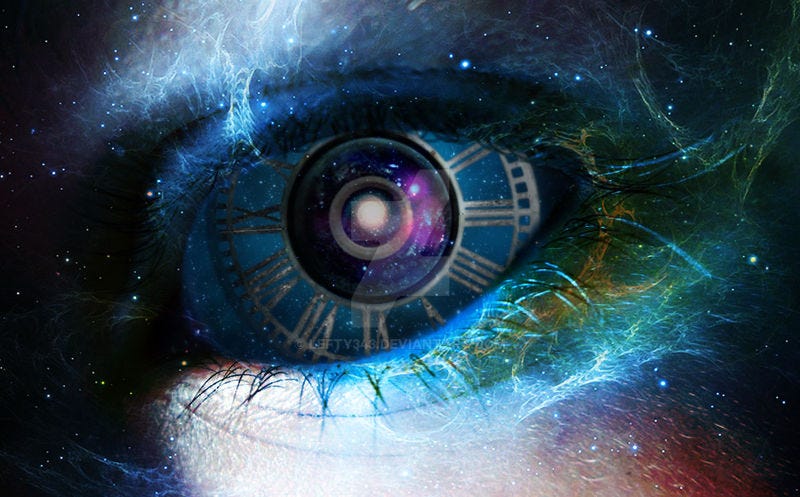
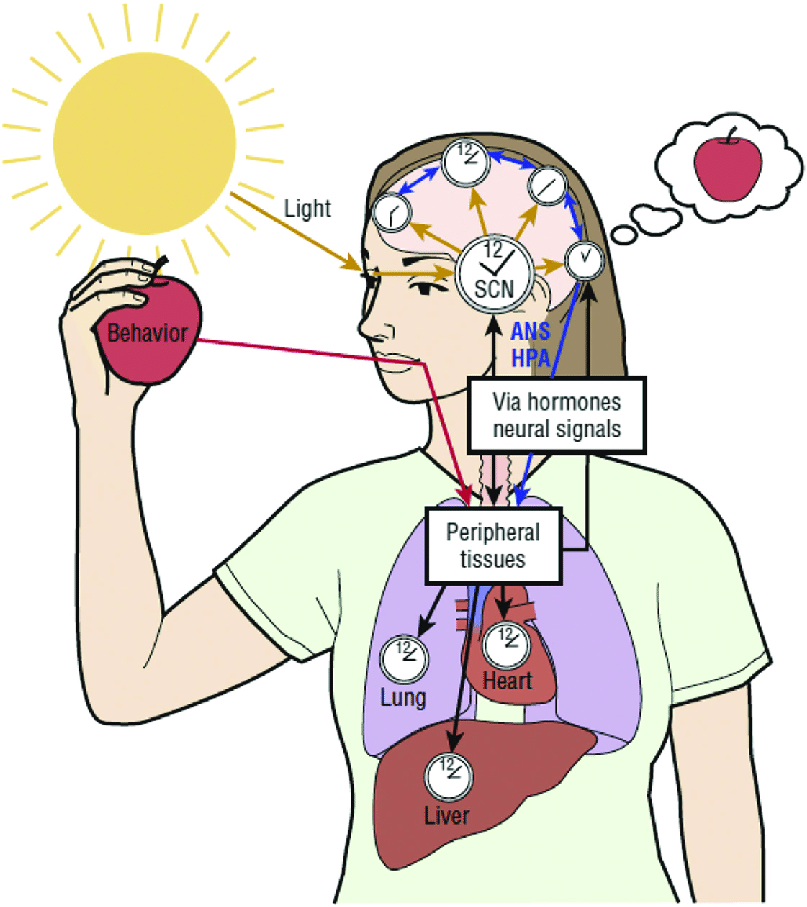


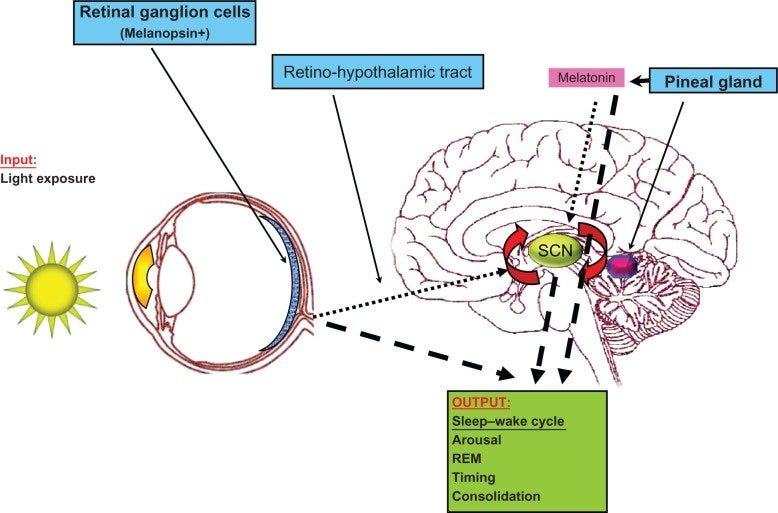
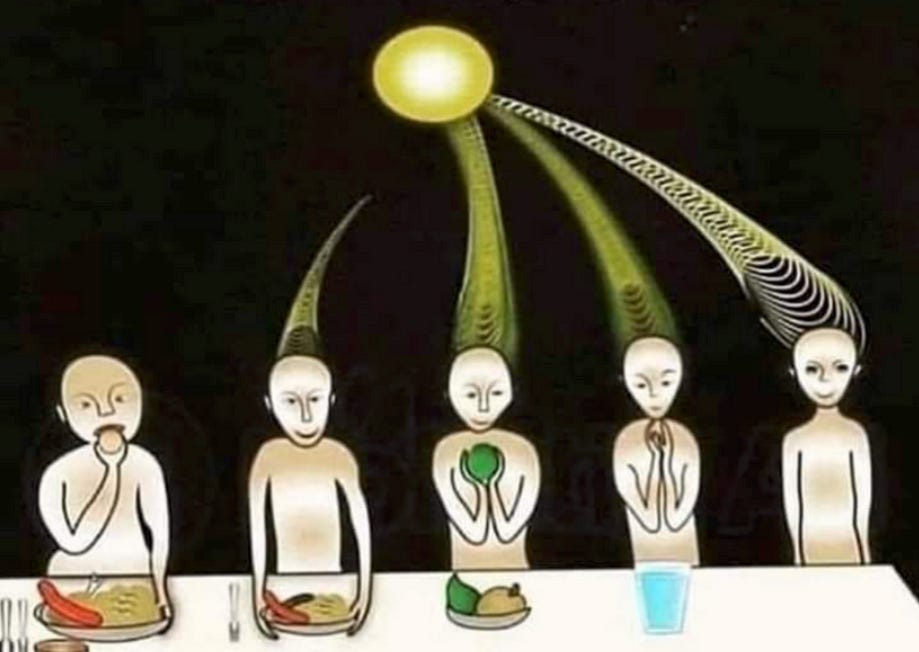
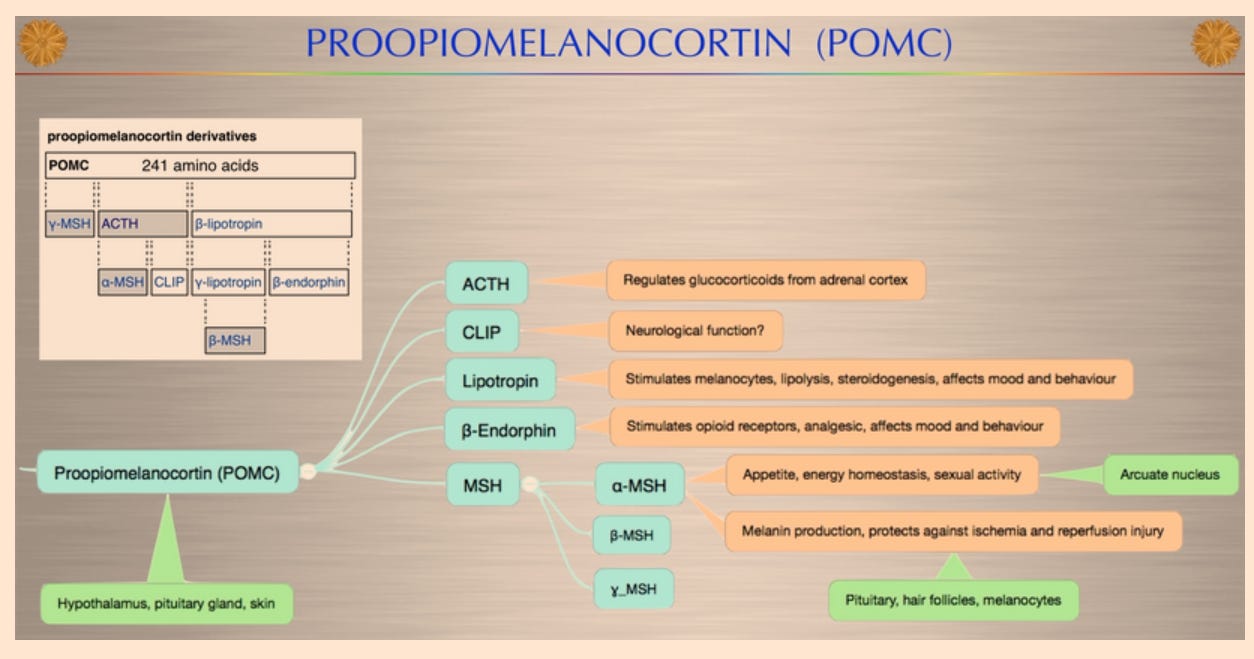

Absolutely wonderful summary. I would add that on top of modernity's aversion to sunlight & perversion of blue light, the consumption of seed oils and sugar accelerate macular degeneration.
You guys are ready to have your own peer-reviewed scientific papers!
2 Questions/Comments
1. On this, “After an asteroid wiped out the dinosaurs 65 million years ago, light from the Sun would be sparse….When humans came onto the scene, we had to adapt to these low-light environments.”
I think hominids have only been around a few million years, H. Sapiens less. Seems to me sparse sun from a meteor 65 mil yrs ago should have cleared up long before humans came around? What do you guys think?
2. I see the Pineal Gland there in one chart. Some chatter on-line says temp guns aimed at the head might disrupt this gland and some say it only measures infrared. For a while I was letting them do the wrist, one guy wanted to take my wrist temp to sit on the restaurant’s outside seating with no one around and I just started laughing telling him he was crazy. Didn't go down well with my date.